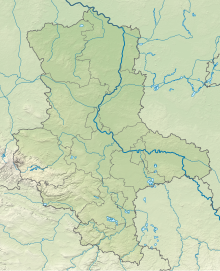Goliath (funk)
|
Goliath
|
|||||
|---|---|---|---|---|---|
| Basic data | |||||
| Place: | Kalbe - Altmersleben | ||||
| Country: | Saxony-Anhalt | ||||
| Country: | Germany | ||||
| Altitude : | 28 m above sea level NHN | ||||
| Coordinates: 52 ° 40 ′ 9 ″ N , 11 ° 25 ′ 19 ″ E | |||||
| Use: | Telecommunication system , military use | ||||
| Demolition : | 1947 | ||||
| Data on the transmission system | |||||
| Number of towers / masts: | 15th | ||||
| Height of the towers / masts : | 170 m | ||||
| Construction time: | 1941-1943 | ||||
| Operating time: | 1943-1945 | ||||
| Waveband : | VLF transmitter | ||||
| Send types: | Directional radio , mobile marine radio , radio navigation | ||||
| Shutdown : | April 1945 | ||||
|
|||||
| Position map | |||||
|
|
|||||
Goliath was a longitudinal wave transmitter operated by the Kriegsmarine from 1943 to 1945 to connect to submerged submarines . The Goliath was located on an area of 263 hectares northeast of Calbe an der Milde, today Kalbe (Milde) . With a transmission power of one megawatt , the system was the most powerful transmitter in the world at the time.
The location in the Altmark on the Milde River was chosen because of the damp subsoil, as good grounding conditions are an important prerequisite for a long range of the transmitter system. In addition, there was a railway connection in the immediate vicinity with the Hohenwulsch – Wittingen railway line.
The first planning began as early as 1936 (when the land was bought up) and in 1940 the Deutsche Reichsbahn began building a three-kilometer-long siding, through which all building materials were later delivered. Work under the management of C. Lorenz AG in Berlin began in 1941 and after a construction period of 27 months, operations began in 1943. As a transmitting antenna, Lorenz used three shield antennas , which were mounted radially around three 210-meter-high tubular steel masts insulated from the ground and which were each attached to six 170-meter-high earthed steel framework masts. The middle three steel truss masts each carried two shield antennas, so that a total of 15 steel truss masts existed.
By operating with longitudinal waves in the range of 15 to 60 kHz, communication with submerged submarines was made possible for the first time at distances over 10,000 km.
Shortly before the end of the war, parts of the transmitter were destroyed by operating personnel in April 1945. On April 11, 1945 troops of the US Army occupied the area and used it as a camp for approx. 85,000 prisoners of war because of the existing high fencing . According to the agreements of the Yalta Conference , at the end of June 1945 the area of today's Saxony-Anhalt and thus also the Goliath transmitter was handed over to the Red Army .
The Goliath, which later served as a model for many similar systems, was repaired in spring 1946 and then dismantled from summer 1946 to June 1947. The remaining buildings and foundations were blown up in the summer of 1947. Today only a foundation of one of the 170 meter high masts remains ( coordinates ).
The dismantled transmitter was initially stored near Leningrad and then rebuilt in 1952 about 10 km south of Nizhny Novgorod ( coordinates ). This transmitter was the first long wave transmitter in the Soviet Union. The transmitter is in operation there almost unchanged to this day and is used by the Russian Navy , u. a. also operated for the time signal service RJH99 .
The name of the transmitter is Голиаф (Goliaf) in Russian at the new location.
The antenna system of the long-wave transmitter Wilejka is very similar to the system of Goliath, but all masts are almost exactly 100 meters higher.
literature
- Gerd Klawitter: 100 years of radio technology in Germany - radio stations around Berlin . Wiss.- und Technik-Verlag, Berlin 1998, ISBN 3-89685-500-X , p. 113-128 .
Web links
- Lattice masts long-wave transmitter Goliath. In: Structurae
- Tube masts long-wave transmitter Goliath. In: Structurae
- Klaus Herold: The longest wave transmitter Goliath near Calbe an der Milde from 1941 to 1945 . (PDF; 1.76 MB) Description, sketches and photos
- Description of the structures, photos of the transmitter and information on the current location



